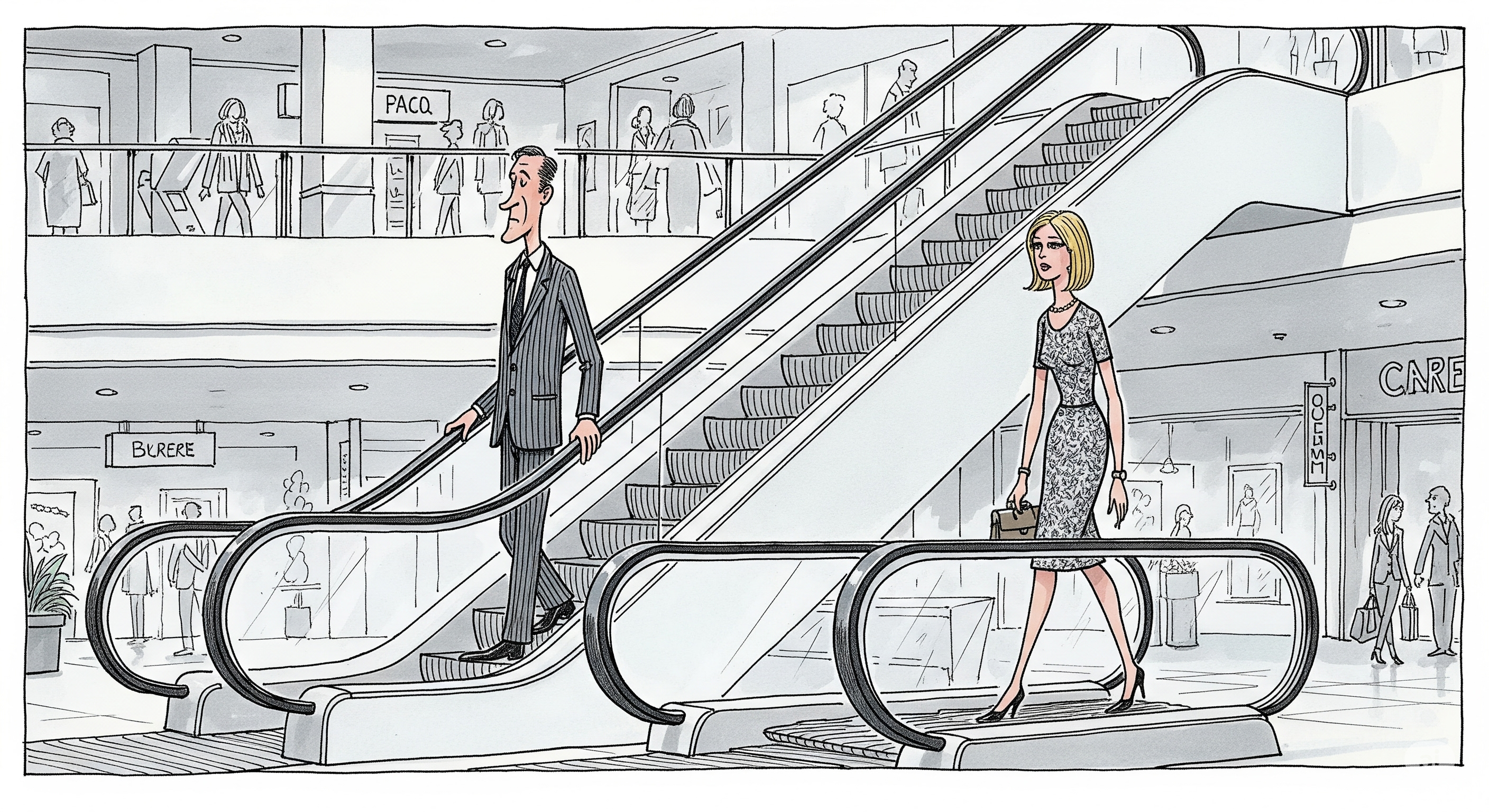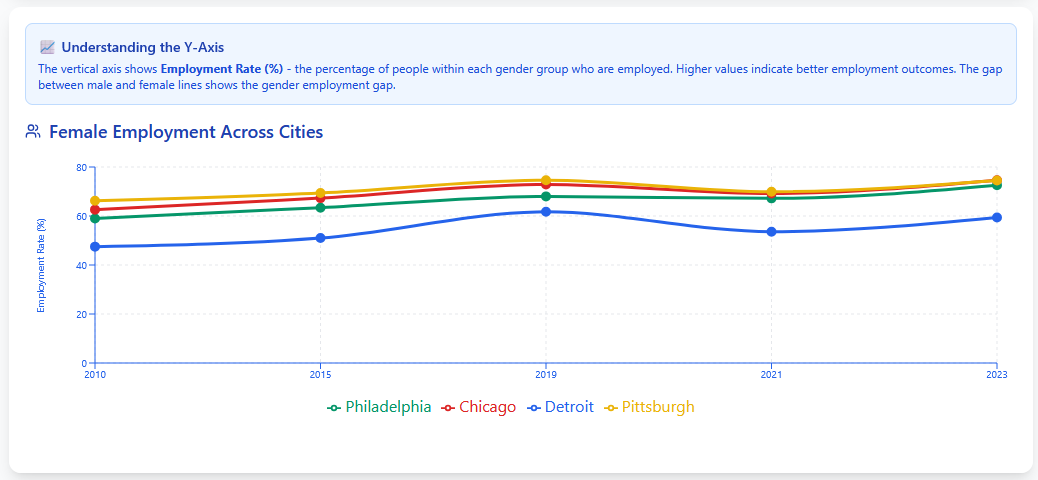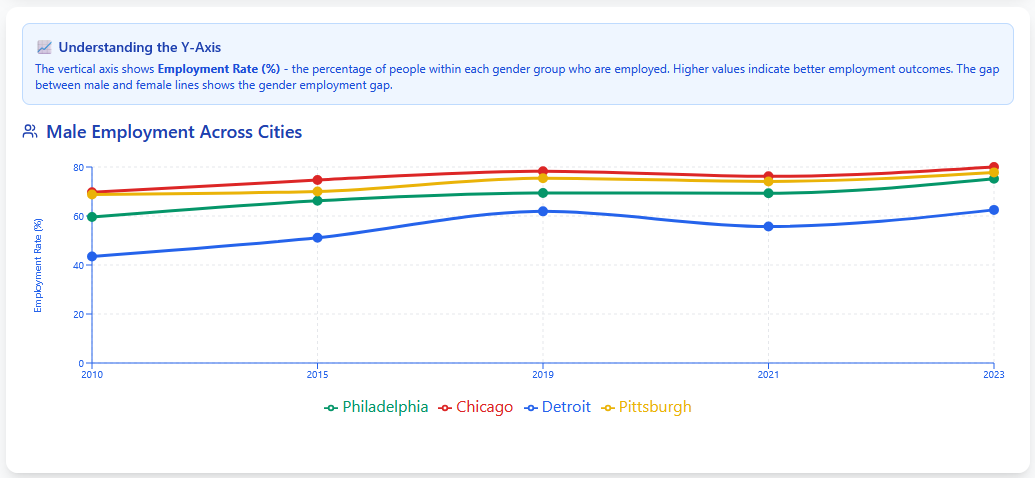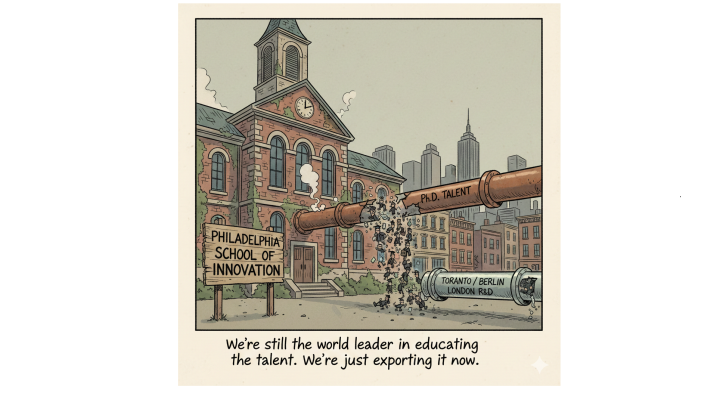10. Macro Indicators: Who’s Working in Philadelphia? A Look at Overall Employment Gains at the City Level by Gender Since 2010 (Gender – Part I)

Our previous analysis revealed notable improvements in workforce participation, including a 72.5% increase in youth employment (ages 16–19), a dramatic 58.2% increase among workers with less than a high school education, and strong growth among Hispanic/Latino workers with a 34.5% increase.
Building on those findings, this edition of Leading Indicators shifts the demographic lens to examine employment patterns across gender over the same 2010–2023 period. By benchmarking against peer cities—Chicago, Detroit, and Pittsburgh—we assess whether Philadelphia’s employment growth, marked by the addition of 379,200 jobs between 2010 and 2023, has translated into measurable gains across gender. In other words, has the economic expansion in Philadelphia fostered equitable workforce participation in the same dimensions for both women and men?
What You Need to Know
- By 2023, both men and women in Philadelphia experienced substantial employment gains, with the male employment rate rising from 59.6% in 2010 to 75.2% in 2023, and the female rate increasing from 59% to 72.6%. While Philadelphia trails Chicago, where 80% of males and 74.6% of females were working, it significantly outperforms Detroit (male 62.5%, female 59.4%) and closely aligns with Pittsburgh (male 77.8%, female 74.5%).
- Although the gender employment rates in Philadelphia appear relatively close, the 2.6 percentage point gap suggests ongoing structural advantages favoring male workers. Key reasons include wage gaps despite higher educational attainment, persistent caregiving burdens on women, and limited childcare access that restricts workforce participation especially for women.
Gender Employment Analysis
In this LI, the metric we primarily look at is the “employment rate” from the American Community Survey—the “Employment-to-Population Ratio,” which represents the percentage of the selected population that is currently employed among all surveyed Americans aged 16 and older.
Overall Trends
Between 2010 and 2023, female employment in Philadelphia across all sectors increased from 59.0% to 72.6% (23.1% growth), while male employment rose from 59.6% to 75.2% (26.2% growth). This implies that while the proportion of employed segments increased for both genders, a higher proportion of males were employed compared to females in 2023. More concerning is the fact that the gap between the proportion of males employed compared to females has widened from 0.6 percentage points in 2010 to 2.6 percentage points in 2023.
Philadelphia's gender employment patterns show both similarities and striking differences when compared to peer cities. While all cities achieved substantial absolute employment gains for both genders, the data reveals that Philadelphia and Pittsburgh experienced widening gender gaps, Chicago made meaningful progress in closing a large initial gap, and Detroit underwent a dramatic gender reversal. Specifically:
- Chicago successfully narrowed its much larger gender gap from 7.1 to 5.4 percentage points during the same 13-year duration (from male 69.7% vs female 62.6% in 2010 to male 80.0% vs female 74.6% in 2023).
- Detroit represents a complete reversal—in 2010, women had higher employment rates than men (male 43.5% vs female 47.5%), but by 2023, this had flipped to a male advantage (male 62.5% vs female 59.4%), suggesting that Detroit's economic recovery disproportionately benefited men.
- Pittsburgh shows a pattern similar to Philadelphia, with its gender gap widening from 2.6 to 3.3 percentage points (male 68.8% vs female 66.2% in 2010 to male 77.8% vs female 74.5% in 2023).
View the full Gender-based Employment Transformation Dashboard here!


Causes & Implications
Although Philadelphia's gender employment rates appear relatively close in 2023—with female employment at 72.6% and male employment at 75.2%—the 2.6 percentage point gap may still indicate persistent structural advantages favoring male workers.
- While both genders have benefited from Philadelphia's economic expansion, male workers continue to experience advantages due to employer preferences or sector-specific hiring patterns that favor men. In contrast, women often face additional barriers, including limited workplace flexibility and caregiving responsibilities. This has been substantiated by reports such as the one by Center for American Progress, which reveals that caregiving responsibilities fall much harder on women than men, with more than 1 in 3 working-class mothers (34.6%) either out of the labor force or working part time because of childcare or family responsibilities.
- The disparity in employment persists despite women's higher educational attainment rates nationally and their strong representation in growing sectors like healthcare and professional services. This indicates that educational advantages alone may not fully overcome labor market inequities that continue to provide marginal employment advantages to male workers. According to research from the Economic Policy Institute, while women now outpace men in educational attainment—with 40% of women completing at least a four-year college program compared to 35% of men—the gender wage gap actually widens with higher levels of education. The gap increases from 20.3% among Americans without a high school diploma to approximately 30% among those with a college degree or higher (Statista). A 2018 report by Georgetown University’s Center on Education and the Workforce further confirmed that, even when comparing men and women who have equal educational attainment and work in the same occupation, women still earn only 92 cents for every dollar earned by men.
- Most critically, Philadelphia faces acute childcare access challenges that disproportionately impact working mothers. According to the Commonwealth of Pennsylvania and the Pennsylvania Child Care Association, the state’s childcare system supports more than 300,000 children each year across the state at a cost of $25 million during FY 2022–2023 and was increased to $31.709 million in FY 2024–2025. However, childcare centers are facing significant challenges in recruiting and retaining staff due to low wages, resulting in reduced capacity and long waitlists for families seeking care. Statewide, as of 2025, approximately 3,000 vacant childcare jobs are preventing 25,000 children from accessing the care they need, forcing many women to exit or reduce their workforce participation to provide childcare. The Pennsylvania Chamber reports that a lack of childcare options leads to an annual economic loss of nearly $3.5 billion for the state, with more than one-third of parents in Pennsylvania reporting that childcare challenges have impacted their employment. The childcare shortage may face additional pressures under the Trump administration’s proposed 2026 budget, which initially proposed eliminating Head Start funding that typically serves approximately 30,000 children statewide across 800+ centers. This uncertainty around federal childcare funding could further limit options for Philadelphia's working mothers, particularly those in low-income families who depend on subsidized care to maintain employment.
Conclusion
Philadelphia's employment data from 2010 to 2023 shows gains for both men and women, with employment rates surpassing those in Detroit and approaching levels seen in Chicago and Pittsburgh. However, disparities persist—the gender gap in employment widened slightly from 0.6 to 2.6 percentage points over the 13-year period. These improvements raise important questions about job quality and economic mobility: are women accessing roles that provide competitive wages and career advancement—as men have—or are they concentrated in sectors with limited job security and upward mobility? The persistence of gender employment gaps—despite women's higher educational attainment—suggests that structural workplace barriers continue to shape employment access and progression. As our previous analyses indicated, while economic expansion has benefited multiple demographic groups, structural challenges affecting women's employment quality and equity remain.

